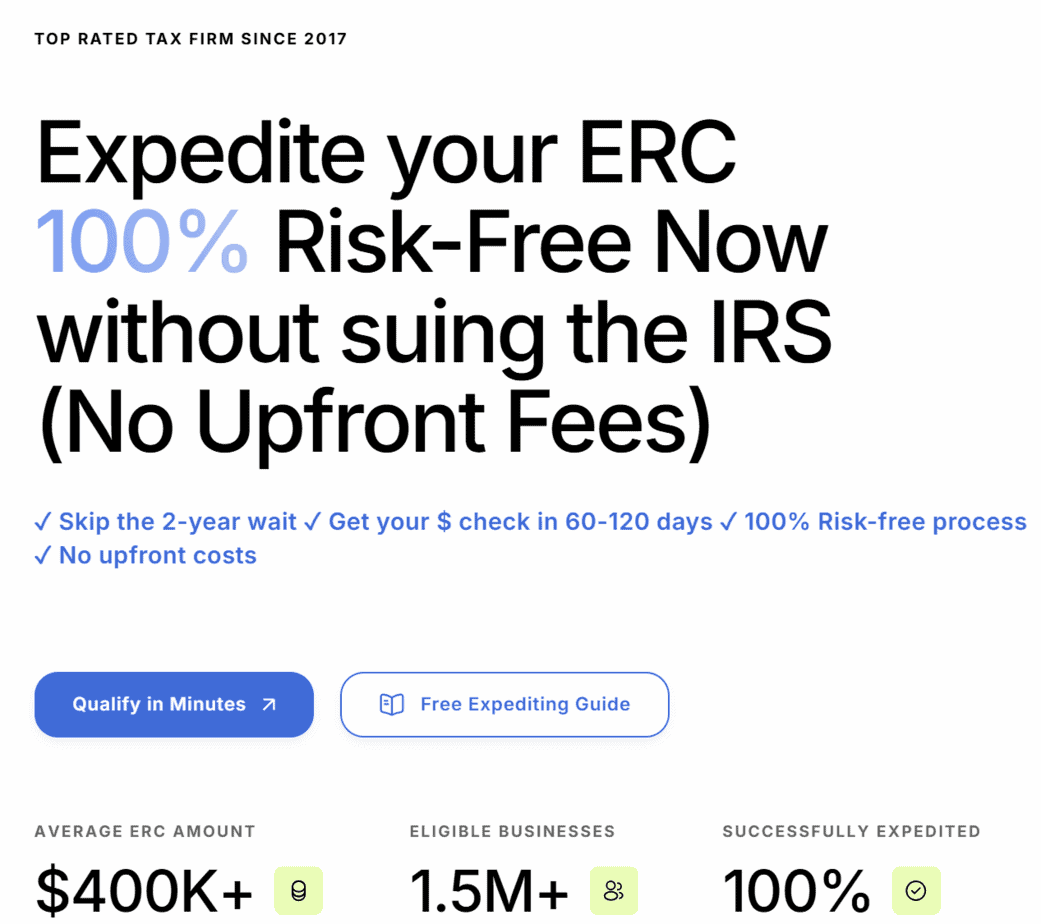- Overview of the Employee Retention Credit (ERC)
- ERC Deadlines and Retroactive Claims
- Qualified Wages and Other Compensation Considerations
- Exclusions from Qualified Wages
- Aggregation Rules and Affiliated Entities (The Technical Stuff)
- Common ERC Pitfalls and Compliance Risks
- How the ERC Affects Other Tax Obligations
- IRS Audit Risks and Enforcement Measures
- Penalties for Incorrect (or Fraudulent) ERC Claims
- ERC Refund Processing Times and IRS Backlogs
- Future of the ERC and Legislative Updates
- Conclusion: Maximizing ERC Benefits While Staying Compliant
Last Updated on April 22, 2025 by Ewen Finser
The Employee Retention Credit (ERC) is one of the most significant relief measures for businesses impacted by the COVID-19 pandemic. Established under the Coronavirus Aid, Relief, and Economic Security (CARES) Act in March 2020, the ERC has undergone several legislative modifications through the Consolidated Appropriations Act (CAA) of 2021, the American Rescue Plan Act (ARPA) of 2021, and the Infrastructure Investment and Jobs Act (IIJA). These changes expanded eligibility, adjusted credit rates, and extended claim periods.
As a licensed CPA, I’ve spent the last 5 years helping clients navigate the choppy waters that are the Employee Retention Credit. Determining qualification can be tricky, especially considering the confusing eligibility criteria, aggregation rules, documentation requirements, and best practices for compliance. However, once a business owner is armed with the knowledge to determine if they qualify, they can access one of the most helpful tax credits that Congress passed during the pandemic.
Most ERC applications are stalled with traditional CPAs and accounting firms. The only firm I've found that is able to expedite and get ERC funds approved in this environment is IRSplus.
Overview of the Employee Retention Credit (ERC)
The Employee Retention Credit (ERC) was (and still is) a refundable payroll tax credit designed to encourage businesses to keep employees on payroll during periods of economic distress brought on by the COVID-19 pandemic. The credit applies to wages paid to employees during specific periods in 2020 and 2021 and can result in significant financial relief for eligible employers.
Congress felt it was imperative to pass the laws allowing the credit as quickly as possible, and for it to be as generous as necessary to keep the American economy from stalling during those unprecedented times. Therefore, they made the amounts of the credit quite generous, and many businesses (including many of the small businesses I serve) received credits to the tune of hundreds of thousands of dollars.
For 2020, the ERC provided a refundable tax credit of up to 50% of qualified wages, capped at $5,000 per employee for the year. For 2021, the ERC was enhanced to 70% of qualified wages capped at $7,000 per employee per quarter for the first three quarters of 2021. This means an eligible employer could receive up to $21,000 per employee in 2021.
ERC Deadlines and Retroactive Claims
Employers can still retroactively claim the ERC by filing Form 941-X (Adjusted Employer’s Quarterly Federal Tax Return) for relevant quarters. The deadline for amending Form 941 follows the statute of limitations, typically three years from the filing date of the original return.
But what are the eligibility criteria for the Employee Retention Credit? To qualify for the ERC, employers must satisfy one or more of the following conditions:
A. Significant Decline in Gross Receipts
- A business would be eligible for the 2020 Employee Retention Credit if gross receipts for a calendar quarter in 2020 were less than 50% of the same quarter in 2019.
- Eligibility ends when gross receipts in a subsequent quarter reach 80% of the comparable 2019 quarter.
- A business would be eligible for the 2021 Employee Retention Credit if gross receipts for a calendar quarter in 2021 were less than 80% of the same quarter in 2019. However, with the 2021 credit, employers can elect to use the immediately preceding quarter to determine eligibility.
- As an example, if a company’s Q1 2021 gross receipts were 78% of Q1 2019, they qualify for the ERC under the 2021 rules.

B. Government-Mandated Suspension of Operations
Businesses that were fully or partially suspended due to government orders also qualify for the ERC. This includes full suspensions which were a complete closure of business operations due to state or local mandates as well as partial suspensions which were restrictions that significantly limited operations (e.g., capacity limitations, curfews, restrictions on in-person services).
To qualify under this criterion, the suspension must impact more than a nominal portion of business operations. An example would be a restaurant that was forced to close indoor dining but allowed to offer takeout may qualify, provided that takeout sales were insufficient to maintain normal operations.
C. Recovery Startup Business (2021 Only)
For Q3 and Q4 of 2021, businesses that began operations after February 15, 2020, and had average annual gross receipts under $1 million can claim up to $50,000 in ERC per quarter, regardless of revenue decline or government shutdowns.
Qualified Wages and Other Compensation Considerations
So what wages are classed as qualified and what else do I need to consider in terms of compensation?
Qualified wages vary based on business size. For small employers (100 or fewer full-time employees in 2020, 500 or fewer in 2021) all wages paid to employees during an eligible period qualify. For large employers (more than 100 employees in 2020, more than 500 in 2021) only wages paid to employees not providing services due to a shutdown or decline in business qualify.
However, the entirety of these years’ wages do not qualify based on periods that were paid out. Like many other government initiatives during the pandemic, there are clear cut-off dates on what does and does not qualify.
The 2020 ERC only covers wages paid March 13, 2020 – December 31, 2020, and for 2021, the ERC covers wages paid January 1, 2021 – September 30, 2021 (unless qualifying as a recovery startup business, which extends through Q4 2021).
Exclusions from Qualified Wages
One thing to be aware of is that certain payments do not qualify for ERC calculations, including wages used to claim PPP Loan Forgiveness, wages used for Work Opportunity Tax Credit (WOTC), and wages reimbursed by other COVID-19 relief programs. To prevent double-dipping, businesses must allocate payroll costs strategically across relief programs.
A qualified CPA (or a firm like IRSPlus that specializes in ERC claims) can help assess what you can and cannot claim. I once helped a construction client who used an ERC mill to originally file their return. He was told that he could receive up to $500K in credits. It sounded too good to be true, and rightfully so, so he came to me to ensure the numbers were aligned with his expectation. I determined that he was rightfully eligible for $340K. Had he not checked with a professional, he could’ve been on the hook for the difference of $160K plus interest and penalties!
Aggregation Rules and Affiliated Entities (The Technical Stuff)
Hypothetically, let’s say you fall under the niche of an individual who owns several LLCs with a parent company owning and controlling its subsidiaries. The IRS requires businesses under common control to be aggregated when determining eligibility. This applies to parent-subsidiary groups, brother-sister groups, and affiliated service groups. Under these rules, gross receipts and employee counts are evaluated at the group level.
Employers using a PEO (Professional Employer Organization, essentially outsourced Human Resource agencies like ADP or Paychex) must work with their provider to ensure accurate ERC claims. The IRS issued guidance (Notice 2021-20) on how PEO clients can claim the ERC despite not directly filing Form 941.
Common ERC Pitfalls and Compliance Risks
Although the ERC provides substantial financial relief, businesses must be mindful of potential pitfalls that could lead to rejected claims, penalties, or audits. Some of the most common issues and compliance risks associated with the ERC can be easily avoided by adhering to the IRS guidelines. Some of the most common problems are misunderstanding aggregation rules, double dipping with other relief programs, insufficient documentation, and ERC scams involving third party companies.
Misunderstanding Aggregation Rules
When it comes to controlled group aggregation, many businesses incorrectly assess their employee count by only considering their specific entity instead of the full controlled group. Under IRS law, if multiple businesses are under common control (e.g., same ownership or management), they must aggregate employee counts and gross receipts to determine ERC eligibility.
An example would be if Ty owns a restaurant chain with multiple LLCs, each operating under different names but all controlled by him, the IRS considers them a single entity for ERC purposes. If total employees across all locations exceed the ERC threshold, the business might not qualify under small employer provisions.
Double Dipping
Another common mistake is double dipping with other relief programs. Business owners must ensure they do not claim ERC wages that were also used for:
- Paycheck Protection Program (PPP) Loan Forgiveness
- Families First Coronavirus Response Act (FFCRA) Paid Leave Credits
- Work Opportunity Tax Credit (WOTC)
- Shuttered Venue Operators Grant (SVOG)
- Restaurant Revitalization Fund (RRF)
The IRS requires employers to carefully allocate payroll costs among these programs. Improper allocation can lead to over-claims and IRS penalties.
For example, a business that received a PPP loan and used 100% of wages for loan forgiveness cannot use those same wages to claim the ERC. However, if they only used 60% of wages for PPP, the remaining 40% may be eligible for the ERC.
Insufficient Documentation
A third common pitfall that businesses may fall victim to is that the IRS requires substantial documentation to support ERC claims. Many businesses fail to maintain adequate records, increasing their audit risk.
Employers must retain payroll records showing wages paid during the qualifying periods as well as gross receipt comparisons for 2019 vs. 2020 and 2021. Additionally, they need to retain copies of government orders (if claiming ERC due to partial or full suspension).
Finally, it would be prudent for businesses to ensure they have copies of their PPP Loan Forgiveness applications to ensure no overlap. Best practice is to keep ERC documentation for at least 4 years after filing.

ERC Scams
A final compliance risk related to the ERC is falling prey to scammy or unethical businesses who claim they will help a business owner get their maximum refund, but then close up shop as soon as any questions are asked.
Due to the generous ERC refunds that are available, fraudulent claims have surged. The IRS has issued warnings about ERC mills—third-party firms aggressively promoting ERC eligibility for businesses that don’t qualify. Some red flags of ERC scams are:
- Promising a “guaranteed” refund before assessing eligibility.
- Charging large upfront fees or fees based on a percentage of the refund.
- Advising businesses to claim ERC without considering PPP loan use.
- Filing inaccurate or exaggerated claims, which could result in IRS audits, penalties, and repayment demands.
Once again, it is best practice to work with a qualified CPA or tax professional to validate eligibility before filing.
How the ERC Affects Other Tax Obligations
Now that a business owner knows they qualify for the ERC, it would be prudent to consider how the credit would affect future tax obligations. The IRS does not allow businesses to deduct wages used for the ERC as a business expense. This means businesses may need to amend prior-year tax returns (Form 1120, 1065, etc.) to remove wage deductions that were later credited through the ERC.
But what about state taxes? Some states conform to federal tax treatment (requiring wage deduction adjustments), while others do not. Businesses should check state tax laws to determine the impact on state tax liabilities.
Finally, the ERC reduces employer Social Security tax liabilities, but businesses still need to file corrected payroll reports (Form 941-X).
IRS Audit Risks and Enforcement Measures
The IRS is actively auditing ERC claims, especially those filed by third-party ERC mills or businesses that misinterpreted eligibility. Things that may trigger IRS audits are large ERC claims relative to payroll size; claims without supporting documentation (e.g., no evidence of revenue decline or government order); businesses with PPP loans that failed to properly allocate wages; and claims submitted by flagged ERC promoters.
If you’re under notice because you thought you qualified for the ERC, how should you approach the situation?
If a business receives an IRS audit notice, the first thing it should do is review the filing to ensure eligibility was correctly calculated. It should then gather all supporting documentation, including payroll records, revenue statements, and government orders. Lastly, before taking on the IRS, consult a tax professional before responding or have them respond on your behalf. If an error was discovered, an amended filing should be done proactively and the difference paid.
Penalties for Incorrect (or Fraudulent) ERC Claims
If a business did not qualify for the Employee Retention Credit, the business owner would need to repay the ERC funds, plus interest. If the filing was accidentally inaccurate, there could also be civil fraud penalties up to 75% of the erroneous refund. If there was deliberate fraud, criminal penalties are not out of the question, although these have been few and far between.
ERC Refund Processing Times and IRS Backlogs
Due to high ERC claim volumes, IRS processing times have been significantly delayed. In 2022 and 2023, some businesses waited 6-12 months for refunds. Currently in 2025, the IRS is prioritizing audit reviews, slowing down processing for new claims.
However, if you qualify for the ERC and plan to amend your previous returns, the best practices for faster filing are to file complete and accurate claim to avoid processing delays. Additionally, use direct deposit if available for refunds. And finally, avoid amending multiple quarters at once, as this can trigger IRS scrutiny.
Future of the ERC and Legislative Updates
Although the ERC applied only to 2020 and 2021 wages, Congress has considered further extensions of the ERC for certain industries. With this in mind, more aggressive IRS enforcement actions are being implemented to prevent fraud. And previous returns are being sifted through and undergoing further scrutiny to ensure only those who qualified received the money they deserved. Employers should stay updated on IRS guidance and legislative changes to ensure compliance.
Conclusion: Maximizing ERC Benefits While Staying Compliant
The Employee Retention Credit remains a lucrative opportunity for businesses impacted by COVID-19. Employers should carefully assess their eligibility under the gross receipts decline method, government-ordered shutdowns, or the recovery startup business provision.
With the IRS increasing enforcement, businesses must maintain meticulous records to justify their claims and avoid penalties. If claiming the ERC, ensure proper tax planning to maximize benefits while remaining compliant with tax laws.
For businesses still evaluating their ERC eligibility, I would recommend consulting a CPA or tax firm specializing in ERC claims to maximize benefits while ensuring full compliance.
Most ERC applications are stalled with traditional CPAs and accounting firms. The only firm I've found that is able to expedite and get ERC funds approved in this environment is IRSplus.


